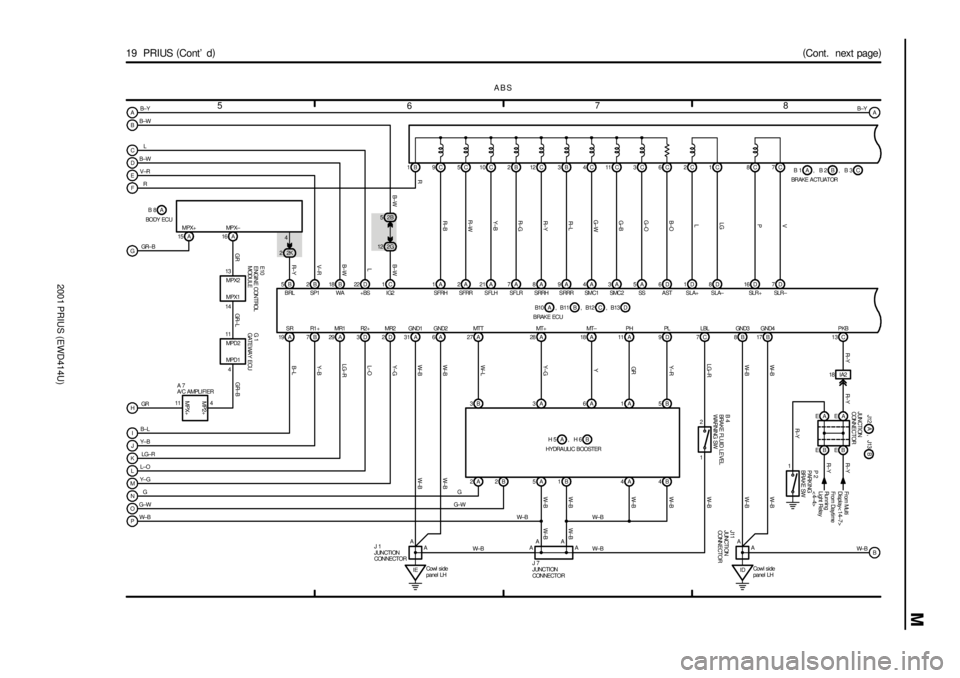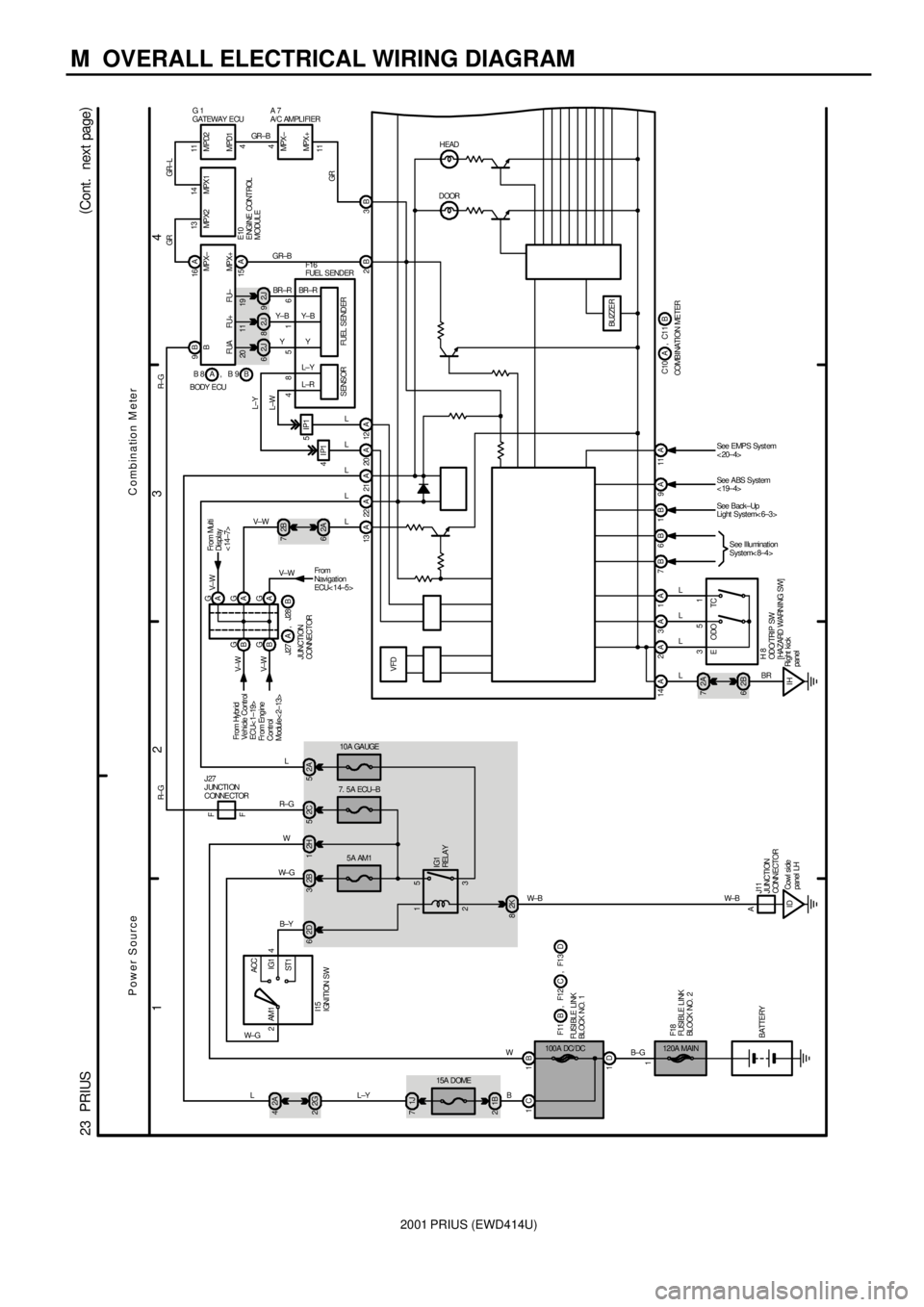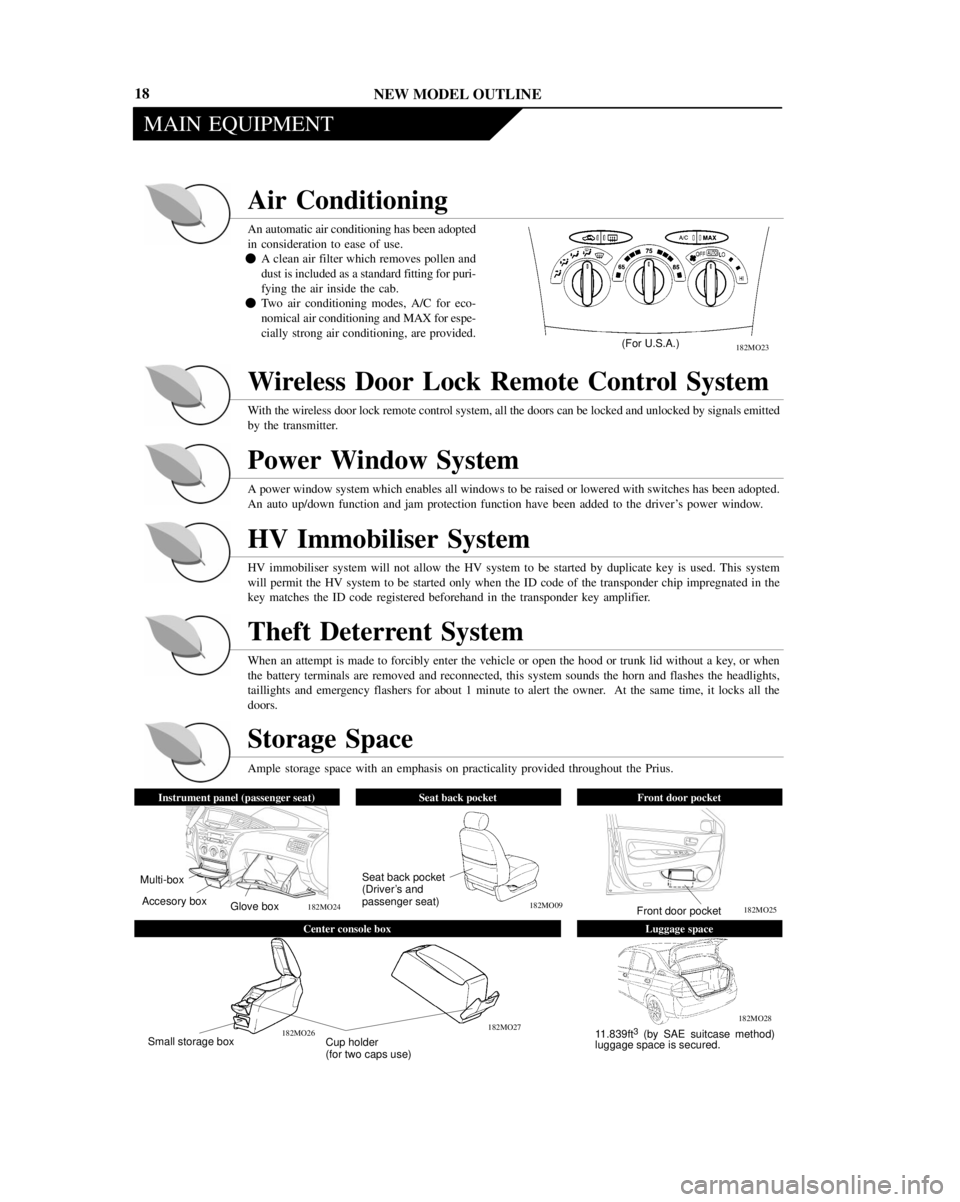Page 255 of 1943

2001 PRIUS (EWD414U)
M
78
6 5
(
Cont. next page)
19 PRIUS (
Cont' d)
15 A 16 A
13
11 14
4
GR GR±L
2K 2
5B 2B 18B 22D C B
1C
J G
H
KI F
L
M
N
O
P19A 7B 29A 3D 2D1B
2B 5
2G 129C5C10C2B12C3B 4C11C3C6C2C1C
1A2A21A7A8A9A4A3A5A6D1D8D
31 A 6 A 27 A 28 A 18 A 11 A 9 D
2A 2B
IECowl si de
panel LH3B 3A 6A 1A 5B
5A 1B 4A 4B7C
1 28B 17B
IDCowl si de
panel LH 8C 7C
16 D 7 D
B D
EB±W
V±R
RL B±W
GR± B
GR
B± L
Y± B
LG±R
L±O
Y± G
G
G±W
W±BR± Y V± R B± W
MPD 1 MPX1
SR BRL SP1 WA MPX2
MPD 2 B 8
BODY ECUA
ABS
G
G±W
W±B W±B
W±B W±BW± B
GR±B
R1 + MR1 R2+ MR2 GND1 GND2 MTT MT+ MT± P H PL LBL GND3 GND4SFRH SFRR SFLH SF LR SRRH SRRR SMC1 SMC2 SS AST SLA+ SLA± SLR+ SLR±
11
A
AAA 4
4
AA A
L B± W B± WR± B R±WY±B R± GR± YR± L G± WG±B G±OB±OL LGP V
B±L Y± B LG±RL±O Y± G W± B
W± BW± L Y± GY GR Y± R LG±RW± B W± B
W±B W±B
W±B
W±B W±B
W±B W±B
W±B W±B
MP2+
MPX+
B10 B11,
BRAKE ECUAB
H 5 H 6,
HYDRA ULI C B OOSTERABB 1 B 2,
BRAKE ACTUAT ORAB
R
A
E10
ENGINE CONTROL
MODULEG 1
GATEWAY ECU
A 7
A/ C AMPL I FI ER+BS IG2
J 1
JUNCTION
CONNECTOR
J 7
JUNCTI ON
CONNECTOR
B 4
BRAKE FL UI D LEVEL
WAR NI NG SWJ11
JUNCTI ON
CONNECTOR
B12 , C D, B13B 3 , C
W±B W±B
13 C
18 IA2
1PKB
R±Y R± Y
R±YP 2
PARKI NG
BRAKE SW
AA B± YB±Y
EA EA
EB
R± Y
From Mul ti
Display< 14±7> JUNCTION
CONNECTORB A J12 J13,
R± Y
EB
From Dayti me
Run nin g
Light Relay
<4±4>
MPX+ MPX±
Page 256 of 1943

2001 PRIUS (EWD414U)
M OVERALL ELECTRICAL WIRING DIAGRAM
9
1011 12
19 PRIUS (
Cont' d)
9A 5A 1A
10 A 22 A 23 A 12 A12A8A4A
16 C 25 C 24 C 15 C11A7A3A
9C 28C 27C 18C10A6A2A
5D 13D 20D 19D 3B 10B 4B 1B
To Data Link
Connector 3
<2±5><2±6> Fr om Stop Light SW
<3±4>
24 B 16 B 14 B 22 B15 B 23 B
To Hybr id
Vehicle
Contr ol ECU
< 1±19> < 1±20> To EMPS ECU
< 20±4>
B16A15A 14A13A 19B20B 11B12B24 A21 B
1IB1 2IB1 5IB1
ABS
J10
JUNCTION
CONNECTOR
W±BB10 B11,
BRAKE ECUAB B13, D C , B12B 3 , C B 1 B 2,
BRAKE ACTUATORAB
B WRB WRB WRB WRP±B W± L GR± GG± W
LGVG RR G BRP
W±B L PL
PL Y BR
BR±BB W
(
Shielded) (
Shielded)
(
Shielded) (
Shielded) (
Shielded) (
Shielded)
(
Shielded) (
Shielded)(
Shielded) (
Shielded)
HVI + HVI ± HV O+ HVO± FL+ FL± FSS FR+ FR± RL+ RL ± RS S RR+ RR± RRO RLO VCM PMC E2 SG1 VREG PREG EREG SG2 VFR PFR EFR SG3 VRR PRR ERR SG4 TC D/ G TS STP
(
Shielded)
AA
A
221112
A 4
ABS SPEED
SENSOR FRONT LHA 5
ABS SPEED
SENSOR FRONT RHA23
ABS SPEED
SENSOR REAR L H12
A2 4
ABS SPEED
SENSOR REAR RH (
Shielded) A
W±B B± Y
W± B20 C
BZ6B
IG1
G
13 IA2
G1 2B±Y
DA
EB EB
B±Y
B±Y
J14 J15,
J UNCTI ON
CONNECTORAB
B14
BRAKE
WARNING BUZZERBUZZER
Page 260 of 1943

2001 PRIUS (EWD414U)
M OVERALL ELECTRICAL WIRING DIAGRAM
1
234
23 PRIUS(
Cont. next page)
5
3 1
2
5A AM1
A12H
D 1 C 1B1
120A MAIN1I15
IGNITION SW100 A DC/ DC
4 AM1
ST1IG1 ACC
2
2B 3 2D 6
IDCowl si de
panel LH 2K 8 1B 2
W±B W±B
B±Y W± GW
B WB±GJ11
JUNCTI ON
CONNECTOR BATTERYF18
FUSI BLE L I NK
BLOCK NO. 2IG1
RELA Y
F11 F12,
FUSI BLE LI NK
BL OCK NO. 1BCF13, D
10A GAUGE
2A 5
W±G
15A DOME
1J 722 A 21 A 13 A 20 A 12 A
14A 2A3A1A 7B6B1B9A 11ABUZZER2B 3B
D OORHEAD
Combination M eter Power Source
2A 4
2B 7
2G 2
2A 6 G
A
G
A G
B
G
B
2A 7
2B 6
IHRight kick
panel51
See Illumination
System< 8±4>
LL±YSee Back±Up
Light System< 6±3> See ABS System
< 19±4> See EMPS Syst em
< 20±4>
15 A
2J 62J82J916 A 9B
7. 5A ECU±B
2C 5
BR L L L L
R± GL V± W LL
L
L
L Y Y± B BR±R GR±B GR ±B
From
Navigation
ECU< 1 4±5 >
R± G R± G
GR GR± L
GR V±W
V±W
V± W
J27 J28,
JUNCTION
CONNECTORAB Fr om Engine
Control
Module< 2±13>From Hybr id
Vehicle Control
ECU< 1±19> F
F
J27
J UNCTI ON
CONNE CTOR BODY ECUB A B 8 B 9, F16
FUEL SENDER
E10
E NGI NE CONT ROL
MODUL E
G 1
GATEWAY ECUA 7
A/ C AMPL I FI ER
13 14 11
4 4
11MPX + MPD1 MP X2 MPX 1 MPD2
MPX ±
C10 C11,
COMBINATION METERAB 4IP15IP1L±WL±Y
48516
3
H 8
OD O/ TRI P SW
[ HA ZARD WARNI NG SW] VFD
TC ODO EA G
From Mul ti
Di spl ay
< 14±7> V± W
MP X+ MP X± B
FU± FU+ FUA
19 11 20
BR±R
Y± B
Y
L±Y
L±R
FUEL SENDER SENSOR
Page 261 of 1943
2001 PRIUS (EWD414U)
M
BRAKE SEAT BELT
(
Driver' s Seat)5
68 7
23 PRIUS (
Cont' d)
HI GH BEAM
TURN R
TURN L
SRS
ABS
MA LFUNCTI ON
I NDI CATOR LAMP
SEAT BEL T
(
Front
Pass enger' s Seat)
WATER TEMP.
(
Hi gh)
WATER TEMP.
(
Low)
CRUI SE
OUTPUT CONTROL
CHARGE
OI L
B 5 19A 18A 17A
4B 10A 16A
Combination M eter
See Tur n Signal
Light Sy stem< 5±4>See Headlight System
< 3±3> <4±4>
Se e SRS Syst em
< 21±3>
See Engine Cont rol
Sy st em< 2± 4> See ABS System
< 19±4> See SRS Sy st em
< 21±3>
C10 C11,
COMBI NATI ON METE RAB
Page 274 of 1943

NEW MODEL OUTLINE
182MO18
182MO19
182EG03
kW
60
50
40
30
20
10 N´m
120
11 0
100
90
80
Engine Speed (rpm) 1,000 2,000 3,000 4,000 5,000(52/4,500)
(111/4,200)
Torque
Output
15
HV Battery Charging
When high load operation is continued, the engine
does not stop to charge the HV battery even
if the vehicle is stopped, in order to keep the
HV battery charged to a given level. (when
ªREADYº light is ON.) ;however, the engine does
not charge the HV battery when the lever is
shifted into the ªNº position.
The engine speed may also be increased during normal
traveling in order to charge the HV battery.
1NZ-FXE Engine
The new Prius is fitted with a 1.5 � gasoline engine which has been developed for the use with the TOYOTA
hybrid system. A mass of leading-edge technology has been implemented to achieve excellent fuel economy,
low emissions, light weight, compactness, and low vibration and noise.
Outline of the 1NZ-FXE Engine Engine performance curve
1NZ-FXE
Displacement (m�)1,497
TypeDOHC 4 valves
Bore y Stroke (mm)75.0 y 84.7
Compression ratio13.0
Maximum output [kW (HP)/rpm]52 (70)/4,500
Maximum torque [N´m (lb´ft)/rpm]111 (82)/4,200
FuelGasoline
Page 275 of 1943

NEW MODEL OUTLINE
MAIN MECHANISM
182CH29
16
4 Features of the 1NZ-FXE engine
1. Highly efficient and high expansion ratio gasoline engine
Adoption of a super fuel-efficient engine developed for use with THS. Its high expansion ratio cycle is achieved by applying the
Atkinson cycle*1 which obtains high thermal efficiency.
2. Reduction in frictional loss
The maximum engine speed is set at 4,500 rpm to reduce frictional resistance, thereby producing a highly efficient low-speed
engine.
�An offset crankshaft with 12 mm deviation from the center axis of the cylinder bore is utilized to reduce frictional resistance
of the piston.
�Frictional resistance is reduced through the use of low tension valve springs and piston rings.
�Lightweight design has been adopted for reciprocating engine parts.
The above measures for reducing frictional loss contribute to improved fuel economy.
3. VVT-i (Variable Valve Timing -intelligent)
The timing of the opening and closing of the intake valves is controlled by the computer according to driving conditions, such
as engine speed and level of acceleration. Thus, smooth intake and exhaust are achieved to greatly improve torque in the low
and medium speed zones. This also contributes to better fuel economy and purification of exhaust gas. Then the VVT-i function
is used to reduce vibration when the engine starts.
4. Compact, lightweight, and low emission
Adoption of an aluminum cylinder block and compact design of parts. And, by positioning the catalytic converter near the engine
for a backwards exhaust layout, we have been able to reduce emissions when the engine is cold started.
*1 : Atkinson Cycle: Proposed by an English engineer named James Atkinson, this thermal cycle enables the compression stroke
and the expansion stroke of the mechanism to be set independently of each other.
Suspension
MacPherson strut type suspension with L-shape
lower arms has been adopted in the front and
torsion beam with toe control link suspension
in the rear. Also, each component part is opti-
mally located and tuned for both excellent con-
trollability and enhanced riding comfort.
EMPS (Electric Motor-assisted Power Steering)
System
Vehicle speed sensing type electric motor-assisted power steering is fitted as standard. Unlike conventional
hydraulic power steering, EMPS does not depend on an engine for its power source, providing a steering feel
in no way inferior to conventional steering when the engine has stopped. Thus it is suitable for the HV system.
Other merits include improved fuel economy through energy conservation, lighter weight, and no need to fill
the power steering fluid.
Page 277 of 1943

NEW MODEL OUTLINE
MAIN EQUIPMENT
182MO23(For U.S.A.)
Glove box Accesory box Multi-box
Front door pocket
Seat back pocket
(Driver's and
passenger seat)
182MO24182MO09
182MO25
Small storage box
Cup holder
(for two caps use)11.839ft3 (by SAE suitcase method)
luggage space is secured.182MO26182MO27182MO28
18
Air Conditioning
An automatic air conditioning has been adopted
in consideration to ease of use.
�A clean air filter which removes pollen and
dust is included as a standard fitting for puri-
fying the air inside the cab.
�Two air conditioning modes, A/C for eco-
nomical air conditioning and MAX for espe-
cially strong air conditioning, are provided.
Wireless Door Lock Remote Control System
With the wireless door lock remote control system, all the doors can be locked and unlocked by signals emitted
by the transmitter.
Power Window System
A power window system which enables all windows to be raised or lowered with switches has been adopted.
An auto up/down function and jam protection function have been added to the driver's power window.
HV Immobiliser System
HV immobiliser system will not allow the HV system to be started by duplicate key is used. This system
will permit the HV system to be started only when the ID code of the transponder chip impregnated in the
key matches the ID code registered beforehand in the transponder key amplifier.
Theft Deterrent System
When an attempt is made to forcibly enter the vehicle or open the hood or trunk lid without a key, or when
the battery terminals are removed and reconnected, this system sounds the horn and flashes the headlights,
taillights and emergency flashers for about 1 minute to alert the owner. At the same time, it locks all the
doors.
Storage Space
Ample storage space with an emphasis on practicality provided throughout the Prius.
Instrument panel (passenger seat)Seat back pocketFront door pocket
Center console boxLuggage space
Page 282 of 1943
NEW MODEL OUTLINE
EXTERIOR
1,695 (66.7)1,465 (57.6)
mm (in.)
182IN01
182MO01
182IN02
8
Futuristic image and symmetry are reflected in the artistic
design of the new Prius.
Front Design
A short slanted hood highlights the singular front design.
�The defined character lines from the front fender curving around to the rear give off a fresh appeal.
�Crystal-look front combination lamps and compact grille finish off the masked look.
Rear Design
The simple rear design gives out an impression of stability.
�Three-dimensional panel make-up produces a perfect balance in its feeling of presence and stability for
the rear view.
�The rear combination lamps extend around to the sides, giving emphasis to the wide image.